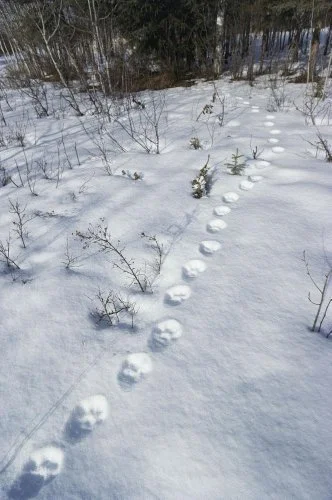Snow conceals, but it can also betray.
Consider the tracks of mice, or wolves, or lynx -- so rarely seen. But here in the frozen dawn the secrets of their passage are plain to see, recorded like marks on a blank page.
You can read how the hare bounded from the forest cover, paused briefly to listen and stare intently (at what?), then was off again. And you can follow the tracks of a lone elk that staggered back and forth across the hillside, searching some remembered comfort before collapsing beneath the weight of hunger or disease, or both.
The ways of man, too, are easy to chart on this white blanket: the parallel lines of a skier, the wide cut of a snowmobile, the tread-marked furrows of a vehicle that slid off course and had to be excavated from the roadside (all is quiet now, but in the brown creases the groaning echoes and the smell of diesel lingers).
Footprints, as well, are captured in this white frame. I remember the prints leading away from my home in the early hours well before sunrise and how I followed them with a flashlight down the street to my empty wallet, new fallen in the snow, and further on to a dumpster in which my camera bag, emptied too, had been tossed.
The tracks went on into a parking lot where the chaos of traffic and the kerfuffle of other lives obscured the path of their escape.
Perhaps this explains why an unbroken spread of snow that coats the valley floor to a depth of several feet, that climbs halfway up the tallest pines and buries the smaller shrubs and saplings, obscuring rocks and roads and fencelines and even the river's flow, is such a welcome sight. How it comforts and inspires!
In the sparkling brilliance of a midsummer sun, is this not the beau ideal of virtue? Of purity? Of peace and justice?
Isn't this the higher purpose to which we aspire, a place of beauty and sweetness and exhilirating perfection unblemished by the tracks of misery and starvation, of mistakes and struggles, of thievery and loss?
Isn't this why we welcome the snow that makes it all right again?

